Concord grapes
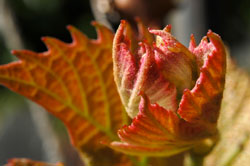 ©Janet Allen
©Janet Allen The newly emerging grape leaves
Concord grapes, a native plant, are another fruit we decided to grow, although we knew nothing about grape growing. But, would they actually produce useable grapes? For us, or just for birds and squirrels?
In 2009, we planted two grape plants in what had been our asparagus bed for many years. Since the grapes were small, we used the bed for other things, too. The grapes are the plants next to the two tall stakes.
Although they were just sticks about 18 inches tall I knew they had to have something to grow on.
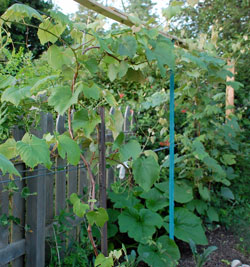 ©Janet Allen
©Janet Allen Grapes our first year before we built the arbor
I put in two 4x4 posts with a wire running at about 3 feet from the ground and about 6 feet from the ground. I dropped twine down from the top wire so they had something to grow up.
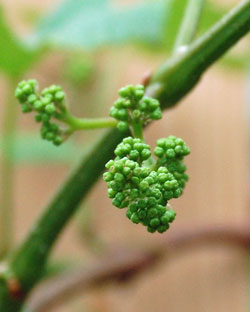 ©Janet Allen
©Janet Allen These little buds promise a future good harvest
The second year I pruned the vines so that "arms" went out from both plants in both directions along the 3 ft wire and in both directions along the 6 ft wire.
That year the vines produced some little clusters and we let three of them grow just to see what would happen. The rest we pruned off as is recommended.
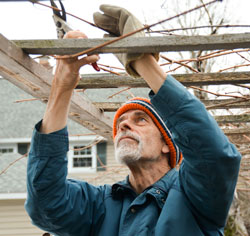 ©Janet Allen
©Janet Allen Pruning grapes in late winter/early spring
The third year I pruned the vines without really knowing what I was doing. Many of the videos on pruning were confusing.
For me the most instructive one was Pruning of Concord Grape Vines (see sidebar). But I also had to read a lot and try to mesh the various instructions into one plan.
My pruning plan
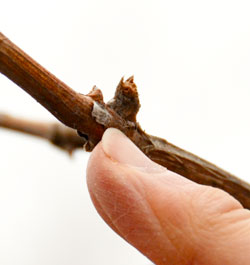 ©Janet Allen
©Janet Allen This is the grape bud in late winter
Here is what I came up with:
- Essential point: Fruit will develop on this season's new growth, which develops from last year's wood. The new growth doesn't exist (except as little buds) at the time you are pruning.
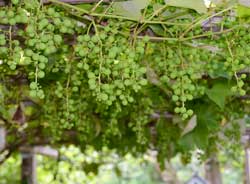 ©Janet Allen
©Janet Allen Not enough pruning or just a good harvest?
Here is what I came up with:
- Pruning takes place in late winter ("when the frost has left the ground, but before the sap in the plants starts to rise"). Remove the previous year's fruiting canes. I have trouble figuring out which those are. Were some of last year's canes fruiting and others not fruiting? I need to figure that out as this year's vines grow.
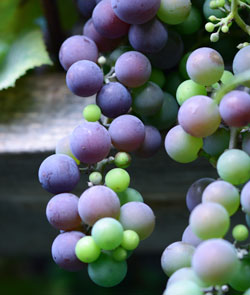 ©Janet Allen
©Janet Allen Concord grapes ripening
- Next, follow last year's new shoots back to the older wood from the year before (which should have coarser bark). From the old growth, come forward four or five buds and cut off the rest of the vine with pruning shears.
- Thin out weak-looking growth and those that cross each other. General advice is that cutting away more shoots leads to stronger and more robust growth during the next season.
I had been much more haphazard at the beginning of the third year of growth, but I followed these instructions in 2012, the beginning of the fourth year of growth.
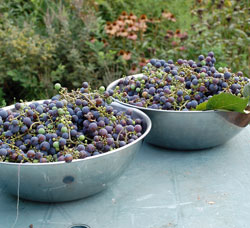 ©Janet AllenOur first grape harvest
©Janet AllenOur first grape harvestThe result as the season progressed was amazing. There were little clusters of "pre-grapes" all over the vines. I suspected that many should be removed but I didn't do anything. Most of them developed into real purple grapes. In the photo we show entire clusters of grapes, which is the recommended method of harvesting. But earlier I had picked grapes one at a time, limiting myself to only ripe grapes because the grapes on a cluster were not ripening at the same time. We ended up picking 25 pounds of useable grapes the first year!
 ©Janet Allen Grape arbor
©Janet Allen Grape arborEarly in the third year I constructed a trellis that went over the path next to the grapes. It would have been better to have done this originally because the result was that the vines on the 6 ft high wire were about six inches below the trellis. In this photo it is clear that most of the growth is off to the left of the trellis, still on the original wires.
As of April 2012, we still have lots of grape jam and frozen grape juice to use before what we hope will be another good harvest.
Problems
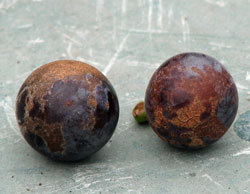 ©Janet Allen
©Janet Allen Problem with grape skin
In 2011, some of the grapes had almost iridescent brownish spots on their skins.We were unable to obtain an identification of what it was but it didn't seem to affect the flavor of the grapes. Could it have been sunburn?
We didn't have that problem in 2012 or 2013.
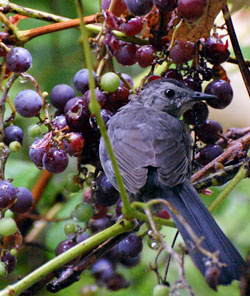 ©Janet Allen
©Janet Allen "Who, me?"
Although we hadn't noticed birds, squirrels or other creatures sharing our grapes in previous years, in the hot droughty summer of 2012 we had problems with birds (mostly house sparrows), so we tried to get out there to harvest individual grapes as they ripened.
We had so many, many grapes in 2013 that there was plenty for all. Although I begrudge the non-native house sparrow thugs' takings, we didn't mind sharing with other birds, such as this catbird, one of our favorite birds.
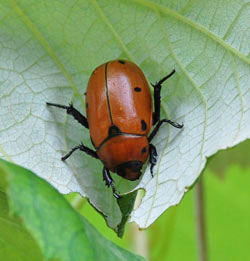 ©Janet Allen
©Janet Allen Grape leaf beetle
In 2010 we had plenty of Japanese beetles chewing the leaves, and in 2011 we found this beetle on one of the leaves. At first we were alarmed, but after some research it was found to be a native beetle, and that it didn't harm the plant.
After keeping it in a jar for a day, we decided that it was best to let things be, and we released it back to the grape vine. We'll see if we have some in coming years.
Despite any problems, though, grapes have turned out to be worth having.
Harvest record
| YR | LB | Notes |
| 15 | ||
| 14 | 14 | |
| 13 | 70 | Prolific harvest of small, but unblemished fruit |
| 12 | 9 | |
| 11 | 25 |

 (Enlarge)
(Enlarge)